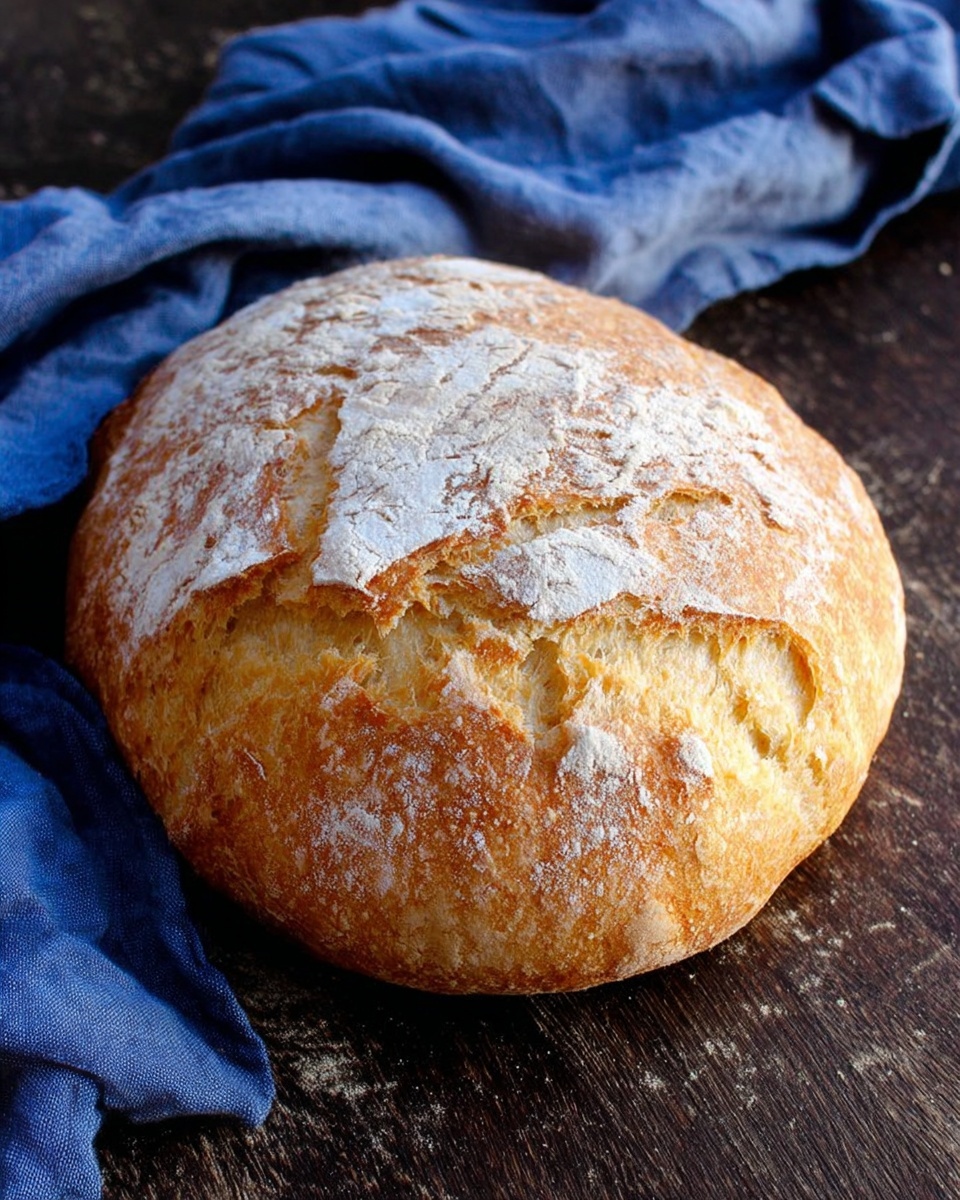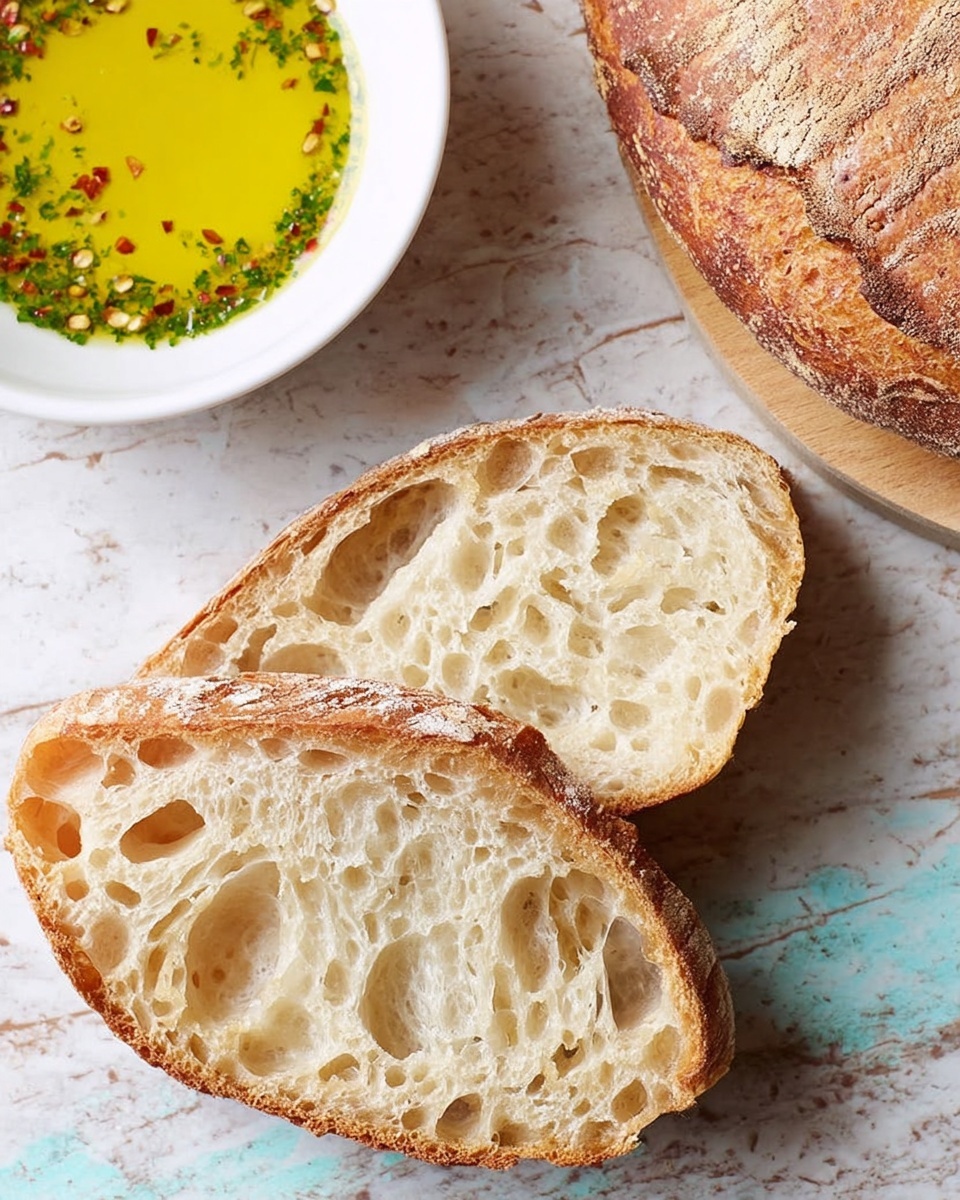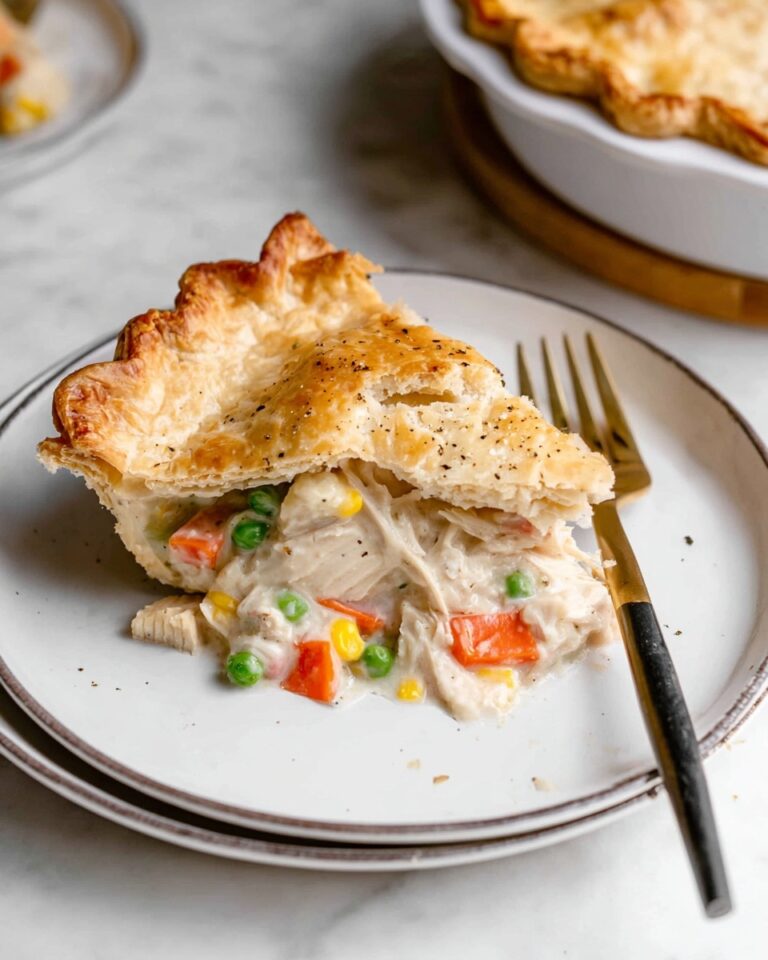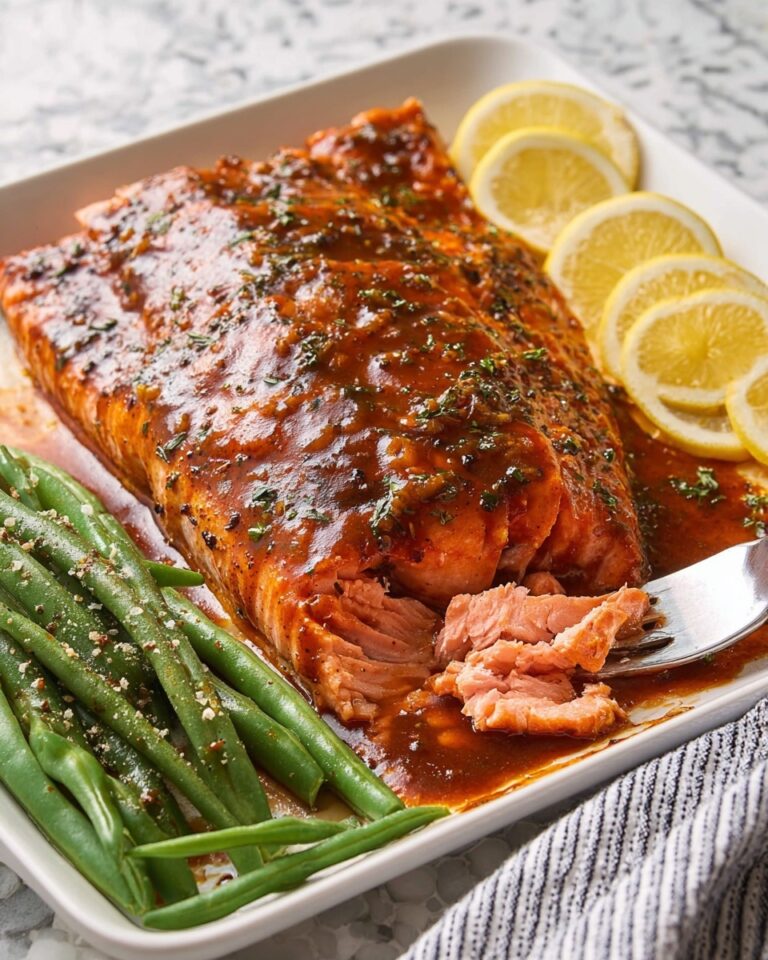Crusty Italian Bread Recipe
If you’ve ever dreamed of biting into a warm loaf with a perfectly crusty exterior and a soft, dreamy interior, you’re going to love this Crusty Italian Bread Recipe. There’s something so comforting about homemade bread that fills your kitchen with that incredible aroma and invites everyone to gather around. This recipe is straightforward, making it perfect for both beginner bakers and those wanting to impress with totally artisan vibes.
I often find myself reaching for this Crusty Italian Bread Recipe when planning family dinners or weekend brunches, because it pairs beautifully with everything from olive oil dips to rich pasta sauces. Plus, once you see how simple it is to create bread with that satisfying crust at home, you’ll wonder why you didn’t start baking yours sooner!
Ingredients You’ll Need
This Crusty Italian Bread Recipe uses classic pantry staples that come together in perfect harmony to give you that crust and crumb combo we all crave. When choosing your ingredients, fresh yeast and good quality olive oil really make a difference, so grab the best you can find!
- Bread flour: The higher protein content helps develop more gluten, essential for that chewy, airy texture inside.
- Warm water: Between 100-110°F is key to activating the yeast without killing it—too hot and your bread won’t rise properly.
- Granulated sugar: Just a touch to feed the yeast and help the crust brown beautifully.
- Active dry yeast: Make sure it’s fresh and lively; you’ll know because it bubbles quickly when mixed with warm water and sugar.
- Butter (room temperature): Adds richness and tenderness to the crumb without weighing down the dough.
- Salt: Essential for flavor and controls yeast activity to prevent the dough from over-proofing.
- Egg white: Brushed on top for that beautiful golden sheen and extra crunchiness on the crust.
- Chilled water: Used with egg white to make a smooth wash for a shiny finish.
- Extra virgin olive oil: A final brush post-bake seals in moisture and adds a subtle fruity aroma.
Variations
One of my favorite things about this Crusty Italian Bread Recipe is how adaptable it is. Whether you want to tweak for dietary needs or just add a flavor twist, there’s room to make it your own. You can easily swap or add ingredients to suit your taste or the occasion.
- Whole Wheat Variation: I once swapped half the bread flour for whole wheat for a nuttier flavor and more fiber. Just keep in mind it needs a slightly longer rise to achieve the right crumb.
- Garlic Herb Twist: Mixing in some finely chopped fresh rosemary or thyme and minced garlic to the dough adds a fragrant punch perfect for dinner parties.
- Gluten-Free Adaptation: I recommend replacing bread flour with a trusted gluten-free flour blend designed for bread and adding a binding agent like xanthan gum.
- Seeded Crust: Before brushing the egg wash, sprinkle sesame or poppy seeds on top for an extra crunch and visual appeal that never fails to impress guests.
How to Make Crusty Italian Bread Recipe
Step 1: Activate the Yeast
Start by mixing warm water (100-110°F) with the granulated sugar and active dry yeast in a large bowl. Give it a gentle stir, then let it sit for about 5-10 minutes until it becomes foamy and bubbly. This means your yeast is alive and ready to work its magic—if you don’t see bubbles, consider starting again with fresh yeast.
Step 2: Make the Dough
Once your yeast is activated, add the bread flour, salt, and room temperature butter to the bowl. Mix everything using a wooden spoon or your hands until it starts coming together into a shaggy dough. Then, turn it onto a lightly floured surface and knead for about 10 minutes until the dough is smooth, elastic, and only slightly tacky. This is my favorite part because you really get to feel the bread’s transformation under your hands!
Step 3: First Rise
Place your dough in a large, lightly oiled bowl and cover it with a damp cloth or plastic wrap. Find a warm spot—like inside your oven with just the light on—and let the dough rise until it doubles in size, usually about 1 to 1.5 hours. Patience here is key; a well-risen dough means better texture and flavor.
Step 4: Shape and Second Rise
After the first rise, gently punch down the dough to release air. Shape it into an oval loaf and place it on a parchment-lined baking sheet. Cover again and let it rise for 30-45 minutes. Meanwhile, preheat your oven to 450°F, and place a baking dish filled with hot water on the bottom rack—this creates steam, which is essential for that gorgeous crust.
Step 5: Bake to Perfection
Before baking, brush the loaf with a mixture of egg white and chilled water to get that beautiful gloss. Bake the bread on the middle rack for about 25-30 minutes until golden brown and crusty. Midway through baking, you can brush on some extra virgin olive oil for a rich finish. To test doneness, tap the bottom of the loaf—it should sound hollow.
How to Serve Crusty Italian Bread Recipe

Garnishes
I love serving this bread with a sprinkling of flaky sea salt on top or a drizzle of good quality olive oil blended with fresh herbs. It adds that final touch of freshness and aroma that elevates every bite—simple but so effective.
Side Dishes
This bread is my go-to for dipping into homemade marinara or a rich, garlicky olive oil dip. I also often pair it with soups like minestrone, or alongside a charcuterie board loaded with cheeses, cured meats, and olives—because who doesn’t want bread ready for all the delicious toppings?
Creative Ways to Present
For special occasions, I’ve tried slicing the loaf and arranging it in baskets lined with colorful linen napkins, or serving it as a bread bowl filled with warm, cheesy spinach dip. These little presentation tweaks make the bread feel like a centerpiece and get everyone excited for that first crunchy bite.
Make Ahead and Storage
Storing Leftovers
I usually keep leftover crusty Italian bread wrapped loosely in a clean kitchen towel inside a paper bag—this keeps the crust from getting soggy while not drying out the inside too fast. If you plan on eating it within a couple of days, this method works great.
Freezing
When I have extra loafs, I slice them and freeze in airtight bags. This way you can toast slices whenever you want without waiting for the entire loaf to thaw. Just make sure to squeeze out as much air as possible to prevent freezer burn.
Reheating
To revive crusty Italian bread, I wrap the loaf or slices in foil and warm them in a 350°F oven for 10-15 minutes. This refreshes the crust without drying the bread out. For slices, just toast lightly and enjoy the fresh-from-the-oven taste again.
FAQs
-
Can I use all-purpose flour instead of bread flour in this Crusty Italian Bread Recipe?
While bread flour is ideal for its higher protein content that helps develop gluten and create a chewy texture, you can substitute all-purpose flour if that’s what you have. Just know your bread might be slightly less chewy and have a softer crust but will still taste delicious.
-
Do I need to add steam while baking the bread?
Yes, adding steam—like placing a pan of hot water in the oven—helps keep the crust from forming too quickly so the bread can expand properly and develop that beautiful, shiny crust typical of Italian bread. If you skip this step, the crust may be harder and less glossy.
-
How do I know when the bread is fully baked?
The best test is the “hollow sound” test—carefully tap the bottom of your loaf; it should sound hollow. The crust will be golden brown and firm to touch. If unsure, you can use an instant-read thermometer—the internal temperature should be around 190-200°F.
-
Can I make this dough overnight?
Definitely! After the first knead, you can refrigerate the dough overnight for a slow fermentation. Just bring it back to room temperature before shaping and let it rise as usual. This method often improves flavor and texture even more.
-
Why does my crusty Italian bread sometimes end up soft instead of crusty?
This usually happens if there’s too much humidity or if you store the bread wrapped tightly when still warm. To maintain that signature crust, bake with steam in the oven, and let the bread cool completely on a wire rack before wrapping. Avoid plastic wrap which traps moisture and softens the crust.
Final Thoughts
Making this Crusty Italian Bread Recipe at home has been one of my most satisfying cooking adventures because it’s simple yet delivers bakery-quality results. The smell while baking alone is enough to brighten your whole day, and sharing fresh bread straight from your oven is almost magical. I truly encourage you to give it a try—you’ll feel proud with every crunchy bite and want to bake it again and again!
Print
Crusty Italian Bread Recipe
- Prep Time: 20 minutes
- Cook Time: 25-30 minutes
- Total Time: 2 hours 45 minutes
- Yield: 1 loaf (about 12–14 slices) 1x
- Category: Bread
- Method: Baking
- Cuisine: Italian
Description
This Crusty Italian Bread recipe delivers a golden, crunchy crust with a soft, airy interior, perfect for sandwiches, dipping, or enjoying with butter and olive oil. The bread is made using a traditional wet dough method, allowing for a flavorful, chewy crumb and an authentic rustic appearance.
Ingredients
Dough Ingredients
- 650 grams bread flour (approximately 5 1/4 cups)
- 1 3/4 cups warm water (between 100-110°F)
- 1 tablespoon granulated sugar
- 1 tablespoon active dry yeast
- 1 tablespoon butter, room temperature
- 2 teaspoons salt
Glaze Ingredients
- 1 egg white
- 1 tablespoon chilled water
- 1 tablespoon extra virgin olive oil
Instructions
- Activate the Yeast: In a small bowl, combine the warm water (100-110°F) with the granulated sugar and active dry yeast. Stir gently and let it sit for 5-10 minutes until it becomes frothy, indicating the yeast is active.
- Mix the Dough: In a large mixing bowl, add the bread flour and salt. Make a well in the center and pour in the activated yeast mixture along with the room temperature butter. Stir together to form a sticky dough.
- Knead the Dough: Transfer the dough to a floured surface and knead for about 8-10 minutes until the dough is smooth, elastic, and slightly tacky but no longer sticky. Add small amounts of flour as needed to prevent sticking.
- First Rise: Place the dough in a lightly oiled bowl, cover with a damp cloth or plastic wrap, and let it rise in a warm, draft-free area for about 1 to 1.5 hours or until it has doubled in size.
- Shape the Loaf: Punch down the risen dough and turn it out onto a lightly floured surface. Shape it into a round or oval loaf, depending on preference, and place it on a baking sheet lined with parchment paper.
- Second Rise: Cover the shaped loaf with a damp towel or plastic wrap and let it rise again for about 45 minutes until it puffs up.
- Prepare the Glaze: In a small bowl, whisk the egg white with the chilled water to create a glossy wash. Brush this mixture gently over the surface of the risen loaf. Drizzle or brush extra virgin olive oil lightly over the top for added flavor and crustiness.
- Score the Bread: Using a sharp knife or bread lame, make a few shallow slashes across the top of the loaf to allow steam to escape and to create the classic rustic appearance.
- Bake the Bread: Preheat your oven to 220°C (425°F). Place the baking sheet with the loaf into the oven and bake for 25-30 minutes, or until the crust is deep golden brown and the bread sounds hollow when tapped on the bottom.
- Cool: Remove the bread from the oven and place it on a wire rack to cool completely before slicing. This ensures the bread finishes cooking internally and prevents it from becoming gummy.
Notes
- For the best crust, place an oven-safe dish with water on the bottom rack of the oven during baking to create steam.
- Use bread flour for higher gluten content to develop a better structure and chew.
- Let the bread cool completely before slicing to preserve texture and crumb.
- The egg white glaze gives a shiny crust, while olive oil enhances flavor and texture.
- Store leftover bread wrapped in a cloth bag or bread box at room temperature for up to 3 days.
Keywords: Italian bread, crusty bread, homemade bread, rustic bread, crusty Italian loaf, bread baking







